
The photography of Art Wolfe covers the globe, capturing landscapes, wildlife, and cultures from every continent; here he talks through a selection of his favourite images. Art Wolfe is an American photographer and conservationist. His photographs have been noted by environmental advocacy groups for their “stunning” visual impact. Here: Icebergs in Antarctica. “I can never get enough of photographing icebergs. Their gradients of icy blue are mesmerising, as are their endless shapes. I love the way the green arch surrounds the distant blue icebergs, and how some of the blue-green ice is showing just below the water’s surface”. (Photo by Art Wolfe/The Guardian)

Spiritual Journey. “The waters of the Ganges have long been regarded as purifying and sacred among the Hindu religion, due largely to the fact that the river originates high in the nearby Himalayas. In this photograph, a pilgrim sets out upon the Ganges as the sun rises above the distant shore”. (Photo by Art Wolfe/The Guardian)

“Arctic hares mainly feed on woody plants, but they will also eat other things, from moss to seaweed. These hares are in a territorial dispute on the tundra of Canada”. (Photo by Art Wolfe/Art Wolfe Stock)
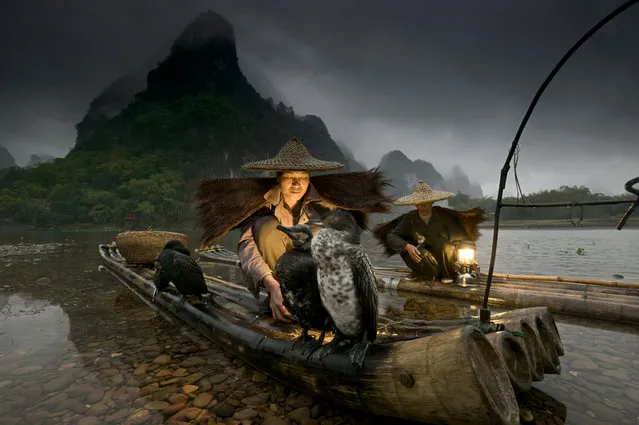
“Lit by lanterns, fishermen along the shores of the Li River prepare their cormorants for an evening of fishing. A tradition unique to Guangxi in south central China, fishermen have always trained the cormorants to dive after and catch fish attracted to the light of the lantern”. (Photo by Art Wolfe/Art Wolfe Stock)

“The lush micro-climate of the Haida Gwaii/Queen Charlotte Islands is home to many colorful creatures. Marine life thrives in oxygen-rich waters, while on land, spruce trees reach for the stratosphere. Batstars, also called seabats because of their webbed rays, bejewel tidepools in a galaxy of mauves, purples and pinks. British Columbia, Canada”. (Photo by Art Wolfe/Art Wolfe Stock)
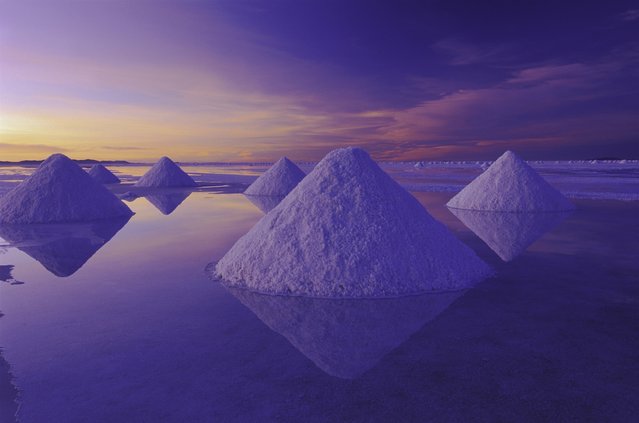
“Pyramids of salt reflect the pink hues of predawn light rising above the Salar de Uyuni in the Altiplano of central Bolivia. The salt flat is one of the largest in the world and a remnant of an ancient lake”. (Photo by Art Wolfe/Art Wolfe Stock)

“We were traveling through Benin when an adobe building caught our eye. We stopped to photograph it and suddenly some children trailed by puppies appeared. This image captures one of many serendipitous moments we encountered in our travels”. (Photo by Art Wolfe/Art Wolfe Stock)

“Floating markets are a common tradition throughout Southeast Asia where the numerous rivers and waterways are a primary means of transportation and commerce between villages. In this overhead view, Bangkok vendors draw their boats together to exchange a colorful, tasty array of goods, Thailand”. (Photo by Art Wolfe/Art Wolfe Stock)
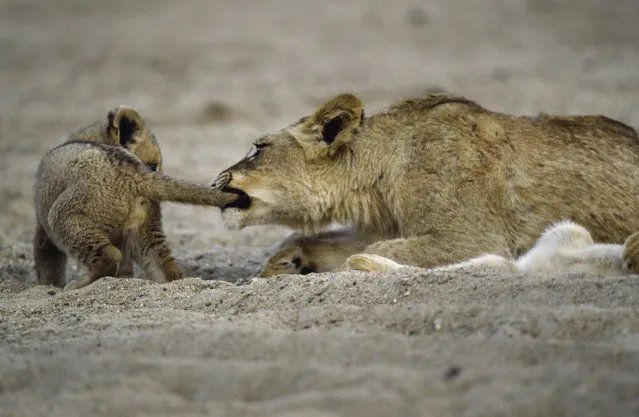
“A second year African lion cub playfully bites a first year cubs tail in Kruger National Park, South Africa”. (Photo by Art Wolfe/Art Wolfe Stock)

“Standing at the door of a Burmese temple a young girl wears traditional face cosmetic called thanaka painted in the shape of a leaf. Thanaka is a paste made from the bark of the thanaka tree and it is popularly used in Myanmar”. (Photo by Art Wolfe/Art Wolfe Stock)

Walrus, Round Island, Alaska. “Round Island hosts this all-male beach party every summer. With no females present, these comical subjects drop their usual competitive guard and settle in. Working atop a high cliff, I utilized depth of field and perspective to allow the patterns of these large marine mammals to come forward. The overcast light emphasized their varying flesh tones”. (Photo by Art Wolfe/Art Wolfe Stock)

“A Grizzly bear runs through a river trying to catch a fish in the Katmai National Park located in Alaska. Bear (Ursus arctos) are hungry after a long winter of hibernation in the Sub Arctic”. (Photo by Art Wolfe/Art Wolfe Stock)
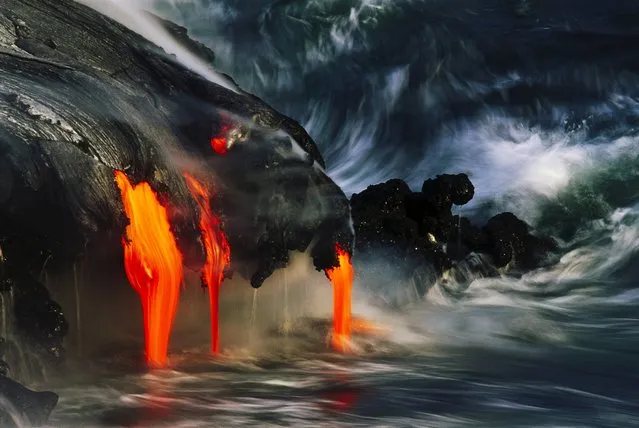
Lava Flow, Kilauea Volcano, Hawaii Volcanoes National Park, Hawaii, USA. “Few places on Earth demonstrate the dynamics of land formation as clearly and dramatically as the “Big Island” of Hawaii. Here the continual island-building process through time has created Mauna Loa, from base to summit the largest volcano on Earth, and Kilauea, the world's most active volcano. At sea level, the building process is an amazing sight to witness as 1,250°Celsius (2,200°Fahrenheit) magma escapes from the Earth's interior, flows to the ocean's edge, and quickly solidifies upon falling into the tumultuous waters of the seas. The superheated lava often explodes on entering the cool ocean waters”. (Photo by Art Wolfe/Art Wolfe Stock)

“Adolescent elephant seals are exceptionally engaging subjects. Elephant seals are found on many subantarctic islands such as South Georgia, as well as along parts of the Argentine coast. While the island supports limited vegetation and terrestrial life (75 percent of the island is under snow and ice), marine life is abundant”. (Photo by Art Wolfe/Art Wolfe Stock)

Fishermen on Inle Lake, Myanmar. “Here people practice a very unique style of fishing, gently lowering thimble-shaped nets in a very shallow lake over fish hiding in the water grasses; they then rap their oar against the net, disturbing the fish and causing them to swim into the net”. (Photo by Art Wolfe/The Guardian)

Bajau seaborne settlement in Semporna, Sabah, Malaysia. “Sometimes called sea gypsies, the Bajau have little allegiance to any country. They distrust Malaysia, the Philippines and Indonesia. They live in boats and small stilted homes. They are fishermen and speak their own language”. (Photo by Art Wolfe/The Guardian)
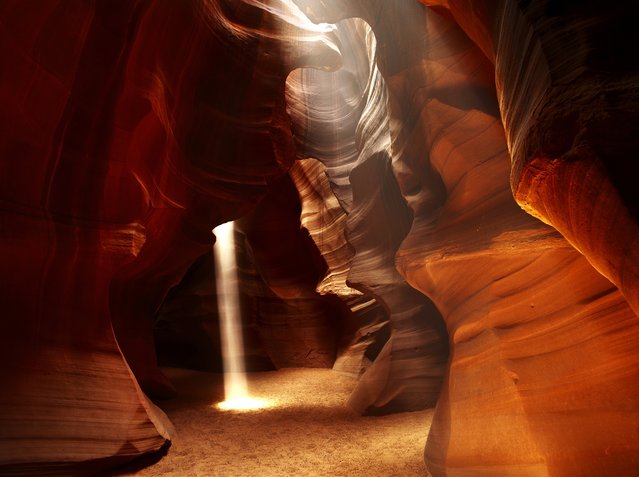
“A single shaft of sunlight illuminates airborne particles of dust. Upper Antelope Canyon in Arizona is about 40 meters (130 feet) deep and except for a couple chambers, it is extraordinarily narrow and twisted”. (Photo by Art Wolfe/Art Wolfe Stock)
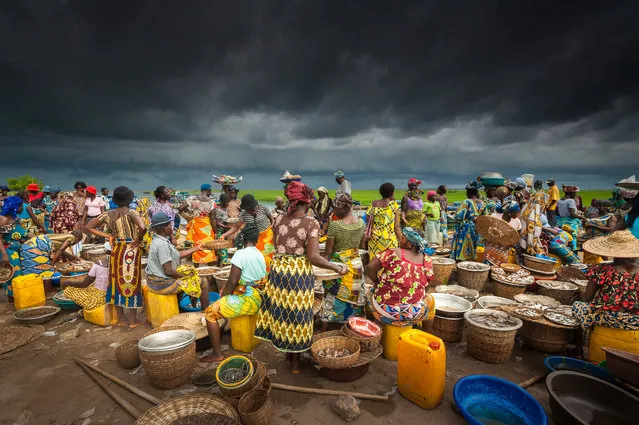
Benin, west Africa. “In the tiny country, large freshwater lakes provide a bountiful harvest for fishermen and open-air markets. This marketplace presents a colourful foreground as a storm builds on the horizon. Moments later, the skies opened in a tremendous downpour, prompting a frenzied search for shelter”. (Photo by Art Wolfe/The Guardian)

Black-browed albatross (Diomedea melanophris), Steeple Jason Island, Falkland Islands, England. “Black Browed Albatross, like all other albatrosses, are long-winged seabirds uniquely adapted to extremely long distance sea flights. They generally only come to land during breeding season when they will rear only one chick. Most albatrosses live on remote islands where man does not live. Consequently, they remain unafraid of the occasional human presence. In this image, the sun sets over the southern Atlantic ocean as ten thousand nesting pairs of black browed albatross settle in for the brief summer night”. (Photo by Art Wolfe/Art Wolfe Stock)

Naked Man festival in Okayama, Japan. “Held on a winter evening, the festival features 5,000 men in loincloths vying for a symbolic baton, which is tossed into the inebriated throng. Whoever possesses the baton receives good luck for the year. The scrum becomes tumultuous when one man catches the baton because anyone who touches him acquires the good luck as well”. (Photo by Art Wolfe/The Guardian)

“Lying along the northwest shore of Panama within the Caribbean Sea, a small group of islands known as the Bocas del Toro (“Mouths of the Bull”) provide a rich rain forest environment supporting a vast variety of wildlife. With their surrounding coral reefs and shallow waters, these scores of islands, keys, and islets are part of a complex of marine parks and bird sanctuaries”. (Photo by Art Wolfe/Art Wolfe Stock)

Gentoo penguin on an iceberg in Antarctica. “One bird on one little iceberg is a metaphor for climate change – I love this image for that”. (Photo by Art Wolfe/The Guardian)

Aerial view of camel train in the Sahara, Morocco. “The setting sun over the desert makes an enchanting shadow as a caravan of camel merchants winds its way toward the next stop on its journey. But the story in the air as this photo was captured was no't nearly as enchanting. As my fellow passenger filled six air-sickness bags, I was barely able to concentrate on finding the minuscule line of camels in the vast sea of sand”. (Photo by Art Wolfe/The Guardian)

Kirkjufell and whooper swans in Vesturland, Iceland. “With the right amount of snow an ‘eye’ is revealed in the side of a mountain. It almost looks like the eye in the pyramid on the dollar bill. As I photographed, a pair of swans took flight”. (Photo by Art Wolfe/The Guardian)

Traditional Thai tattoo in Bangkok, Thailand. “These tattoos are the writings of an Indian philosopher. They are thought to protect and bring good luck to the bearer”. (Photo by Art Wolfe/The Guardian)

Humpback whale in Vava’u, Tonga. “Tonga is one of the very few places you can actually snorkel in close proximity to whales. We had just five days on the water but four of them were too windy and the whales were very shy. In a more outgoing moment, one swam by and eyeballed me. It was extraordinary”. (Photo by Art Wolfe/The Guardian)

Asaro mud men in Eastern Highlands province, Papua New Guinea. “Probably the most famous of all New Guinea indigenous people, the mud men are also called bush demons. The whitish-grey body clay represents the colour of death and spirits. Their ancestors, near defeat in battle, were able to scare off the enemy by emerging from the Asaro river so disguised. Lying on my back, I was surrounded by these eerie mask-clad men. I exposed for the mud masks and blew out the sky to give a lightness to the image”. (Photo by Art Wolfe/The Guardian)

Uruguayan caiman emerge from a wetland in Brazil’s Pantanal marsh. “These 5ft midsize members of the crocodile family are not dangerous to humans because they are accustomed to being fed by local ranchers. When one of these bold reptiles came within six inches of me, I used my tripod leg as a largely symbolic barrier”. (Photo by Art Wolfe/The Guardian)

Milky Way over Halemaumau crater, Hawaii Volcanoes national park, Hawaii. “This is the most primordial of images, a vision of Earth at its very infancy in the universe”. (Photo by Art Wolfe/The Guardian)
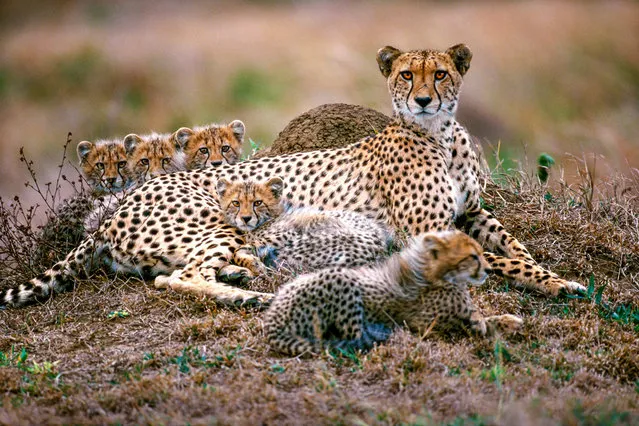
Cheetah and cubs in Phinda reserve, South Africa. “Cheetahs often rest on termite mounds from which they are able to survey their surroundings, as here in Phinda reserve, South Africa. This is a necessity for a mother with many cubs to keep out of harm’s way”. (Photo by Art Wolfe/The Guardian)

Green sea turtle (Chelonia mydas), Galapagos Islands, Ecuador. “This green sea turtle is a favorite because of its simplicity. It passed me while snorkeling in cool waters off the Galapagos Islands and disappeared into the deep blue depths”. (Photo by Art Wolfe/Art Wolfe Stock)

Snowy owlets (Bubo scandiacus), Arctic National Wildlife Refuge, Alaska, USA. “A pair of gray-feathered snowy owlets hunker down in the abundant flowers that flourish in the dropping-enriched soil of their nest mound”. (Photo by Art Wolfe/Art Wolfe Stock)

King penguins (Aptenodytes patagonicus) and Southern elephant seals (Mirounga leonina), South Georgia Island. “On a tiny, ecologically rich island in the sub-antarctic Atlantic, four King Penguins stand in conference unmindful of massive sparring Southern Elephant Seals. The heavy mist of windblown sea foam bathes the entire scene in a primordial fog”. (Photo by Art Wolfe/Art Wolfe Stock)

Iceberg, Jökulsárlón, Breiðamerkursandur, Iceland. “I enjoy working a subject until I eventually discover what I deem to be the best possible composition. That usually happens after I've taken several exposures, getting to know my subject, so to speak. At Jökulsárlón, I literally created my opportunity. As I wandered along the shore, I spotted a tiny (36 kilograms/80 or so pounds, by my estimation) iceberg adrift in shallow water. It looked to be crystal clear with an interesting shape, so I retrieved it and propped it up with some rocks. I then proceeded to take a series of photographs, moving ever closer to the iceberg's polished surface. Under glacial compression the lowest layers of ice become the hardest and clearest. This ice is hundreds of years old if not thousands”. (Photo by Art Wolfe/Art Wolfe Stock)
19 Mar 2018 00:05:00,
post received
0 comments
